From Fish Curry to Coconut Relish: Dishes You Should Try in Sri Lanka
The Teardrop of India or Pearl of the Indian Ocean are among many nicknames for Sri Lanka. But a more accurate description of the gorgeous nation might be the Island of Rice and Curry. Sri Lankan cuisine is known for its particular combinations of herbs, spices, fish, vegetables, rices, and fruits. Here are some you shouldn't miss.
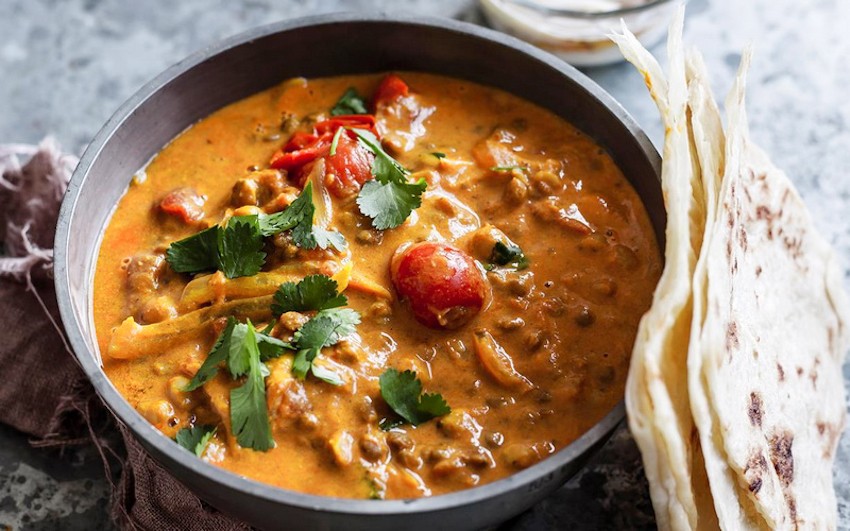 |
| Rice and curry and lunch are synonymous in Sri Lanka. |
Curries
Sri Lankan food offers a vivid array of flavor combinations: sweet caramelized onion relishes, bitter melon, spicy scraped coconut, and the burn of curry tamed by mild rice, and palm sugar sweetened desserts. Considered the national dish of the country, Sri Lankan rice and curry consists of steaming hot, fluffy rice (samba or kakulu varieties) that is served with usually a curry with a thin broth and large chunks of the featured protein (beef, pork, fish, goat, and on from there), plus an assortment of side dishes.
Common accompaniments to rice and curry include sambol (a Sri Lankan relish), a gravy or hodda with spices and coconut milk, mallum (chopped leaves with coconut), and fried crispy foods such as papadams. This specialty is a typical home-cooked dish and an undisputed staple on restaurant menus throughout Sri Lanka.
Fish ambul thiyal (sour fish curry)
As you'd expect from an island in the Indian Ocean, seafood plays an important role in Sri Lankan cuisine. Fish ambul thiyal (sour fish curry) is one of the most beloved varieties of the many different fish curries available.
The fish -- usually something large and firm, such as tuna -- is cut into cubes, then sauteed in a blend of spices including black pepper, cinnamon, turmeric, garlic, pandan leaves and curry leaves. Perhaps the most important ingredient is dried goraka, a small fruit responsible for giving the fish a sour flavor.
Ambul thiyal is a dry curry dish, meaning all the ingredients are simmered with a small amount of water and cooked until the liquid reduces. This allows the spice mixture to coat each cube of fish.
Originating in southern Sri Lanka, it's available throughout the country at restaurants that serve curry, and is best eaten with rice.
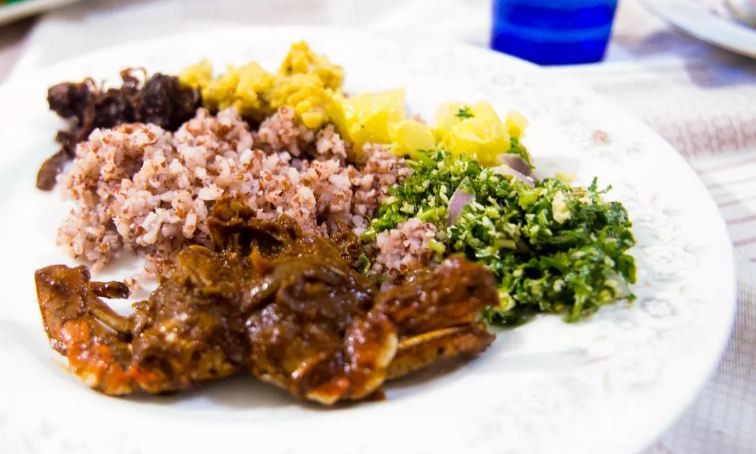 |
| Crab curry with rice, mallum, and side dishes. |
| Seafood curries, meanwhile, often have an additional secret ingredient: the ground, dried stalk of the palm fruit. Used as a thickener and for its nutty flavor, it's not an easy ingredient to find outside Sri Lanka. Crab curry is the stunner, and rightly famous, with the delicate local crab meat absorbing brilliant Sri Lankan spices. |
Kukul mas curry (chicken curry)
Simple to make, chicken curry is a common household dish in Sri Lanka. There are many variations depending on region and taste preferences.
Spices like fennel seeds, cardamom, cloves and cinnamon sticks are tempered in hot oil before being combined with chicken and spices like chili powder, curry powder, turmeric, pandan leaves, lemongrass and curry leaves.
Coconut milk contributes to the rich base of the curry gravy. Depending on the recipe, a puree of tomato is often included.
The chicken is stewed for an hour or so until the essence of the spices is infused into the chicken. Most satisfying when served with hot rice and roti.
Parippu (dhal curry)
Parippu, or dhal curry, is the most common curry in all of Sri Lankan cuisine, a staple in any restaurant or household. Masoor dhal (split red lentils) are first rinsed and boiled until soft.
In a separate pan, a number of fresh ingredients, such as onions, tomatoes and fresh green chilies, are sauteed and mixed with tempered spices like cumin seeds, turmeric, fenugreek, mustard seeds and curry leaves.
All the ingredients are combined and usually thickened with a splash of fresh coconut milk to give the dhal a rich flavor and creamy texture.
It goes with everything, but is perfect as a dipping gravy for a fresh roti or paratha.
Polos (green jackfruit curry)
Jackfruit is consumed in a number of different stages of ripeness, from very ripe and sweet to green and starchy. Polos is a Sri Lankan curry prepared with young green jackfruit.
The fruit is sliced into bite-sized chunks and boiled until soft.
It's then cooked with onions, garlic, ginger and spices like mustard seeds, turmeric, chili powder, roasted curry powder, pandan leaves and curry leaf sprigs. The final step is to add coconut milk and simmer to reduce most of the liquid, leaving all the beautiful flavors within the cubes of jackfruit.
Jackfruit has a starchy texture, somewhat similar to cassava or potato. Polos is a standard dish available at most Sri Lankan curry restaurants.
Other rice dishes
Kuzhambu
Kuzhambu is a traditional Sri Lankan dish gravy that consists of a variety of dals (urad dal, toor dal), tamarind, and (optionally) vegetables. The dish is typically served as an accompaniment to rice. In Tamil cuisine, there are hundreds of kuzhambu varieties, and they all include a base of dals, tamarind, and spices such as chili and curry leaves.
When using vegetables, tomatoes, shallots, plantains, and okra are among the most common choices.
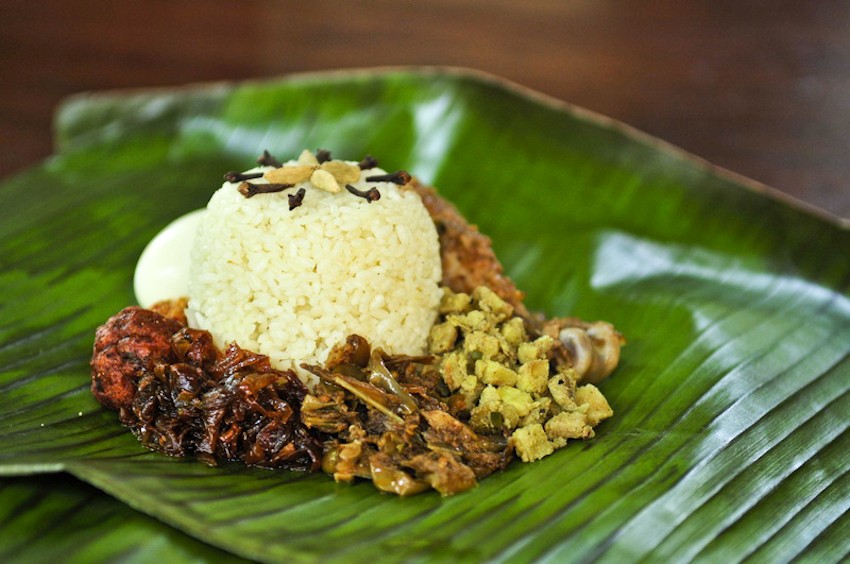 |
| Lamprais is a complex Sri Lankan dish usually consisting of stock-cooked short-grained rice, meat stock -- usually a combination of different meats like beef, pork or lamb -- that's infused with cardamom, clove and cinnamon. |
Lamprais
Sri Lanka has been influenced by a persity of cultures and one of the most evident is the Dutch Burgher community.
Lamprais, a word that combines the two Dutch words for "lump" and "rice," is a combination of meat, rice and sambol chili sauce, wrapped into a banana leaf packet and steamed. The stock-cooked short-grained riceis cooked with three meat curry (beef, pork, and lamb), wambatu moju (eggplant pickle), seeni sambol (onion relish), blanchan (shrimp paste), frikadeller meatballs, eggplant and ash plantain curry, while the common addition also includes fried boiled eggs.
A scoop of rice is placed in the center of a banana leaf, along with the mixed meat curry, two frikkadels (Dutch-style beef balls), blachan (a shrimp paste) and a starch or vegetable, usually either ash plantain or brinjals.
The package is folded into a parcel and steamed. Since lamprais is a Burgher contribution to Sri Lankan cuisine, the meat is usually prepared with sweet spices like clove and cinnamon, recreating the flavor favored by the Dutch Burgher community.
Traditional versions nowadays often substitute meat curries with other types of meat such as chicken, while fish and vegetable versions are also common.
Kool (seafood stew)
This spicy and sour seafood stew is one of the signature dishes of the Jaffna region in Sri Lanka. It combines tamarind-based broth with seafood such as cuttlefish, prawns, crayfish, crabs, as well as different types of fish. Apart from seafood, the dish also incorporates various spices and vegetables, and it is traditionally thickened with odiyal—the flour made from palmyra tuber.
Jaffna kool is usually prepared as a hearty homemade dish, and it is mainly enjoyed on special occasions and family gatherings. It is served as a main course, preferably with pieces of raw coconut on the side.
Side Dishes
On the table with the main curry, there is always a pappadum (lentil crisp), some coconut sambal, and a lentil curry (dhal).
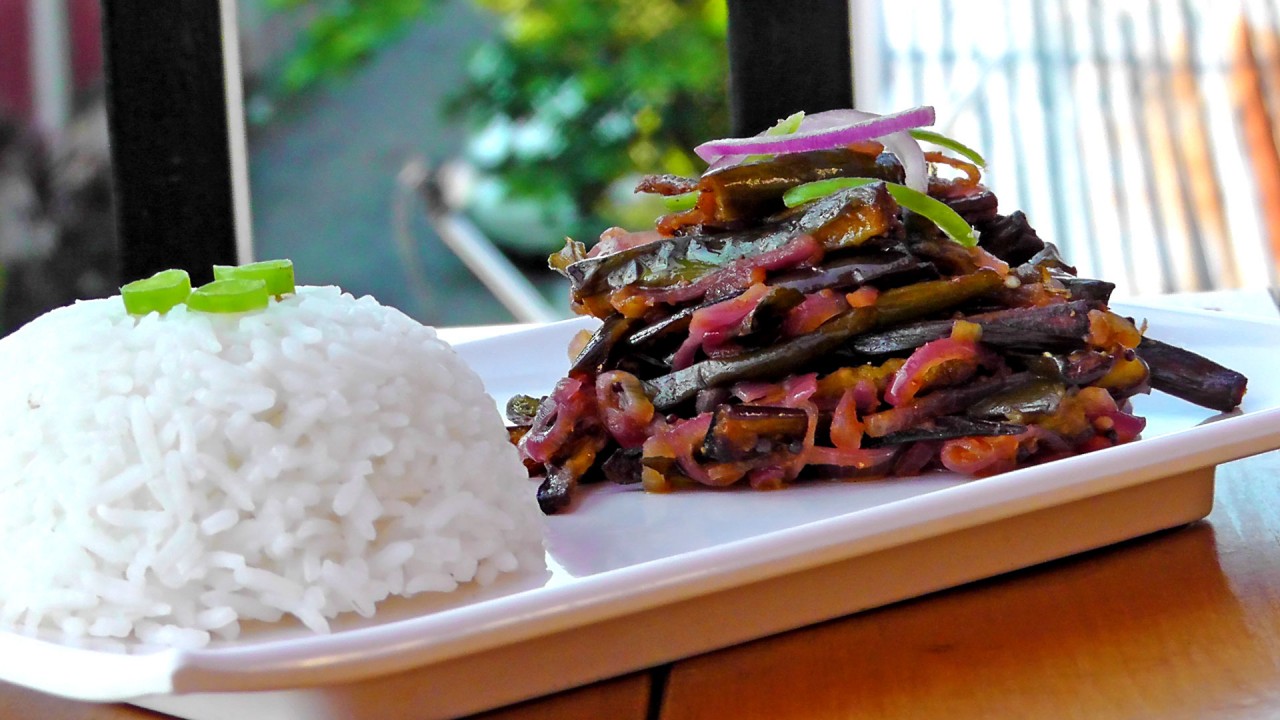 |
| Wambatu Moju is a Sri Lankan fried Egggplant Pickle. Very delicious and best served with rice or as a side dish for a curry. |
Wambatu moju (eggplant/brinjals pickle)
Served mostly with rice and curries, wambatu moju is an extremely flavorful candied eggplant (brinjals) pickle.
The eggplant -- usually the purple-skinned, long and slender variety -- is cut into bite-sized wedges and deep fried, giving the eggplant a crispy texture with a soft and silky interior.
It's then caramelized with a spoon of sugar, vinegar, red onions, green chilies, mustard seeds, chili powder and a hint of turmeric powder until the color turns almost black.
Take a bite and the soft and juicy texture of the eggplant should melt in your mouth -- the slightly sweet, sour and salty contrast is absolutely sensational.
Gotu kola sambol (pennywort salad)
One of the most readily available green vegetable dishes in Sri Lanka is gotu kola sambol.
Gotu kola (known in English as Asiatic pennywort) is a medicinal herb in Asia. It's shredded into slivers, then combined with shallots, tomatoes, fresh grated coconut and chili and seasoned with a dressing of salt, pepper and lemon juice.
Sambol is a term used in Sri Lanka for ingredients that are combined and eaten raw, sometimes more of a chili sauce and sometimes more of a salad, like gotu kola sambol.
Gotu kola has a powerful, herbaceous flavor similar to kale, making it an extremely fresh and crisp dish. It's typically a side dish served with curry and rice.
Kiribath (milk rice)
This simple combination of rice and coconut milk is a staple dish throughout Sri Lanka. The rice is cooked in milk, and the mix is then left to set in a shallow plate. The dish is traditionally cut into square or diamond shapes, and the pieces are usually topped with spicy lunumiris chili paste, or they can be served along jaggery and bananas.
Kiribath represents prosperity and good luck, and it is an integral part of Sinhalese culture, traditionally served to commemorate new beginnings. It is always enjoyed on Sinhalese New Year, and it is traditionally given to children as their first solid food.
Kiribath can be eaten along with a number of different Sri Lankan dishes, often either sweetened with jaggery or consumed salty with chili sauce or curry. One of the most common ways to garnish kiribath is with lunu miris, a sambol chili sauce made from red chilies, onions, lemon juice, salt and sometimes dry Malpe fish, all ground into a paste using a stone mortar and pestle.
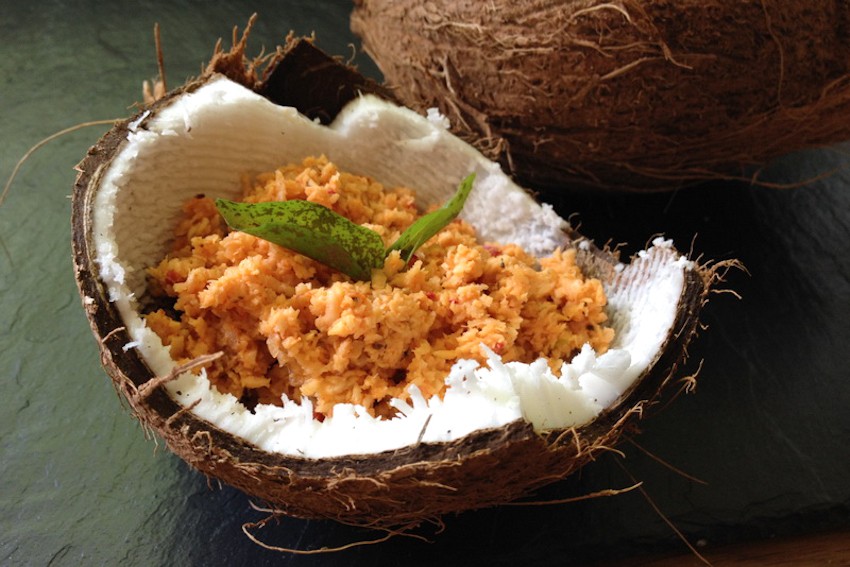 |
| Pol sambol is a traditional Sri Lankan condiment prepared with freshly grated coconut, chili pepper and red onion. |
Pol Sambol (coconut relish)
In a country in which the coconut is of supreme importance, there's one Sri Lankan side dish that pays fitting tribute.
Pol sambol, which might also be called fresh coconut relish, is a simple blend of finely grated coconut, red onions, dried whole chilies or chili powder, lime juice, salt and Malpe fish (if available). The ingredients are diced or ground, then combined in a bowl.
In Sri Lanka, pol sambol is used as a garnish or side dish for everything and anything.
It goes well with rice and curry, pol roti (coconut roti), a hot paratha, string hoppers or even just scooped up with slices of bread. If you love coconut, there's no better garnish in the world.
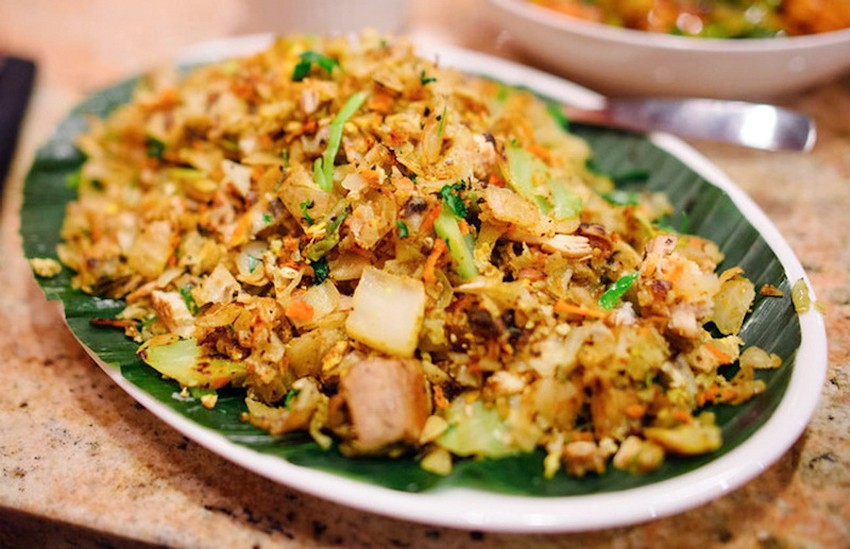 |
| Each kottu is prepared individually on a hot griddle. The process starts with spices such as ginger, garlic, pandan leaves, curry, chili, cardamom, and cinnamon, which are shortly fried to release all their intense aromas. The spices are topped and mixed with carrots, scallions, leeks, or other vegetables, while pieces of sliced roti are added on top. |
Kottu (kottu roti)
Over the traffic and noise at a Sri Lankan market, you'll likely hear the clanking of metal on metal and know kottu isn't far away. Kottu is Sri Lanka's hamburger -- everybody's favorite go-to fast food when craving something tasty and greasy.
It resembles fried rice, except instead of rice, it's made with a type of roti known as godamba roti (a flat, crispy bread).
The roti is normally fried at the beginning of the day, piled into stacks and served as it's ordered. When you place an order, the kottu chef will fry and chop the roti with a selection of ingredients you choose. The result is a tasty mixture of salty pieces of fried dough, lightly spiced and extremely comforting.
Kottu is served with spicy curry sauce, which you can either use as a dip or pour over your entire plate.
Some of the most skilled kottu chefs compose their own unique songs, singing while they rhythmically clank their spatula and knives against the metal frying surface, slicing the roti with each clank.
Dessert
Owing much to the Dutch and Portuguese traditions of sweets—and a little to the Brits and Malays—it's hard to go far in Sri Lanka without running into a sugary treat.
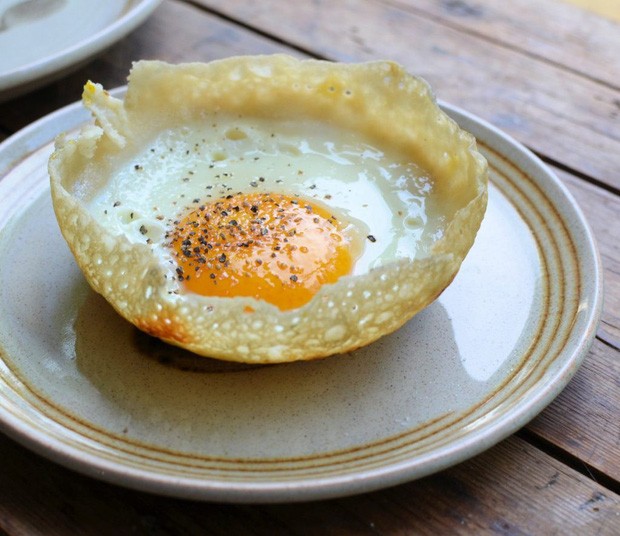 |
| The Sri Lankan specialty known as hopper is like a rice and coconut crepe. ... Hoppers are considered a staple of Sri Lankan cuisine and can come in many forms. |
Hoppers (appa or appam)
Hoppers (also called string hoppers, indi appa or idiyappam) are the Sri Lankan answer to the pancake. The batter is made from a slightly fermented concoction of rice flour, coconut milk, sometimes coconut water and a hint of sugar.
A ladle of batter is fried in a small wok and swirled around to even it out. Hoppers can be sweet or savory, but one of the local favorites is egg hoppers. An egg is cracked into the bowl-shaped pancake, creating the Sri Lankan version of an "egg in the hole."
Egg hoppers are garnished with lunu miris, a sambol of onions, chilies, lemon juice and salt.
Unlike the runny batter used for hoppers, string hoppers are made from a much thicker dough. The dough is squeezed through a string hopper maker, like a pasta press, to create thin strands of noodles, which are steamed.
String hoppers are normally eaten for breakfast or dinner with curries.
Aluwa
In its basic form, this traditional Sri Lankan dessert combines toasted rice flour, sugar syrup, ground cashew nuts, and spices such as cardamom or cloves, while some versions replace sugar with treacle (molasses) and cashews with mung beans or other types of nuts.
The mixture is spread into pans and is then sliced, usually into diamond-shaped pieces. Aluwa is a staple dessert served on Avurudu - the Sinhalese New Year celebrated in April.
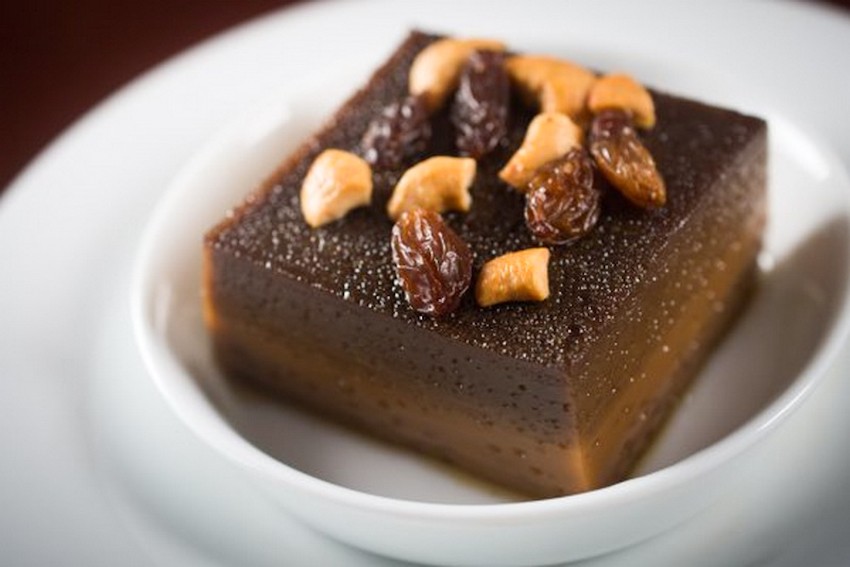 |
| Watalappan (watalappam) is basically steamed coconut milk and jaggery pudding. |
Watalappam (also called watalappan or vattalappam)
It's similar to flan (it is believed to have Malay origins though), but made from coconut and, like any good island dessert, the coconut palm sugar jaggery. Air bubbles keep the thick dessert from getting too heavy, and a good dose of chopped nuts on top gives a little bit of crunch to the otherwise soft sweet.
Wood apple
It wouldn't be a Sri Lankan food discussion without wood apple.
The wood apple is a Southeast Asian fruit about the size of a de-husked coconut. It also has just as hard of a shell, and a pungent, almost blue cheese aroma.
Walking through a market in Sri Lanka your nose will detect it long before your eyes do. Inside the shell is a dark brown paste that resembles something between tamarind pulp and fermented raisins.
Wood apple can be eaten directly out of the shell, but one of the most popular ways to eat (or drink) it throughout Sri Lanka is in a thick smoothie, known as wood apple juice.
The fruit is blended with jaggery (or sugar) and water to smooth it out. It has a unique sour and sweet flavor. Mention that you love wood apple to any Sri Lankan you meet, and they probably won't be able to hold back a knowing smile.
Kokis
Kokis is a Sri Lankan dessert with Dutch origins, consisting of a batter made with coconut milk, eggs, and rice flour. The batter is coated around decorative molds and deep-fried in coconut oil until it develops a crispy texture. Kokis can be consumed as an appetizer, snack, or a dessert, and it is especially popular around Sinhala and Tamil New Year celebrations.
Halapa
It is a mix of kurakkan (red millet) flour, coconut flour, and jaggery wrapped in a kanda leaf and steamed. It has the subtle flavor of the leaf (somewhat similar to a banana leaf), and a distinctive, thick texture, which had me guessing, mistakenly, it was made in part from dried bananas.
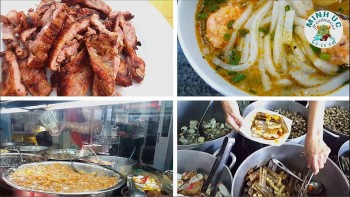 | 10 Best Dishes in Quy Nhon Coastal City and Where to Find Them Grilled spring rolls, lagu bread or dancing shrimp pancakes are three of the specialties visitors cannot miss in coastal areas of Quy Nhon city in ... |
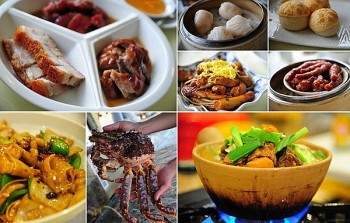 | Classic Hong Kong Food Will Make You Wow Hong Kong is famous for food, and when you visit, you better be ready to eat. |
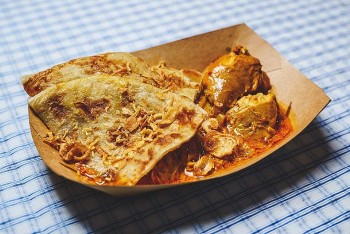 | 6 Flavorful Indonesian Foods You can Make at Home Put these dishes on your Indonesia bucket list; you won’t have trouble finding them when you’re finally able to travel now. |
Recommended
 Travel
Travel
Vietnam Through Australian Eyes: Land of Flavor, Warmth, and Timeless Charm
 Travel
Travel
Strategies for Sustainable Growth of Vietnam’s Tourism from International Markets
 Travel
Travel
Vietnam Strengthens Its Presence On The Global Tourism Map
 Multimedia
Multimedia
Phong Nha-Ke Bang National Park Named Top Adventure Travel Site
 Travel
Travel
Vietnam Welcomes Record-High Number of International Visitors
 Travel
Travel
Luxury Train From Hanoi To Hai Phong To Be Launched In May
 Travel
Travel
Phong Nha Named Top Budget-Friendly Travel Destination for Spring 2025: Agoda
 Travel
Travel


